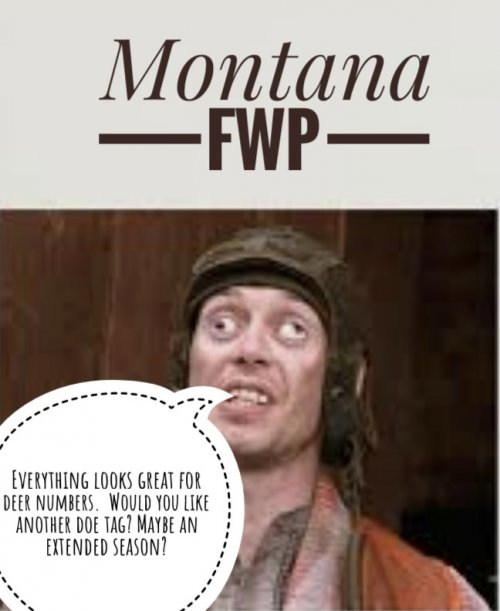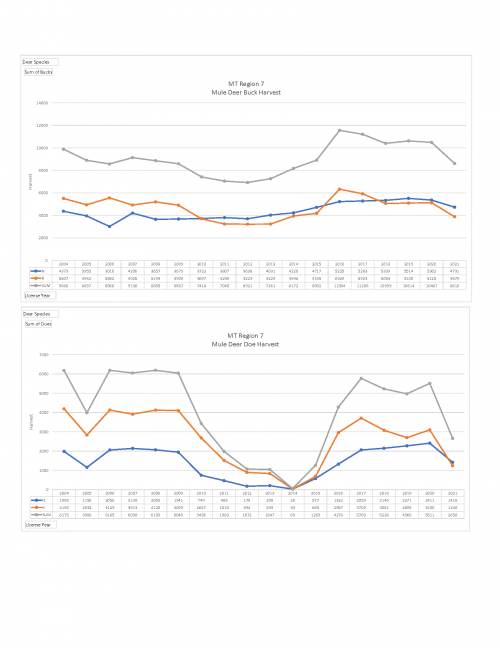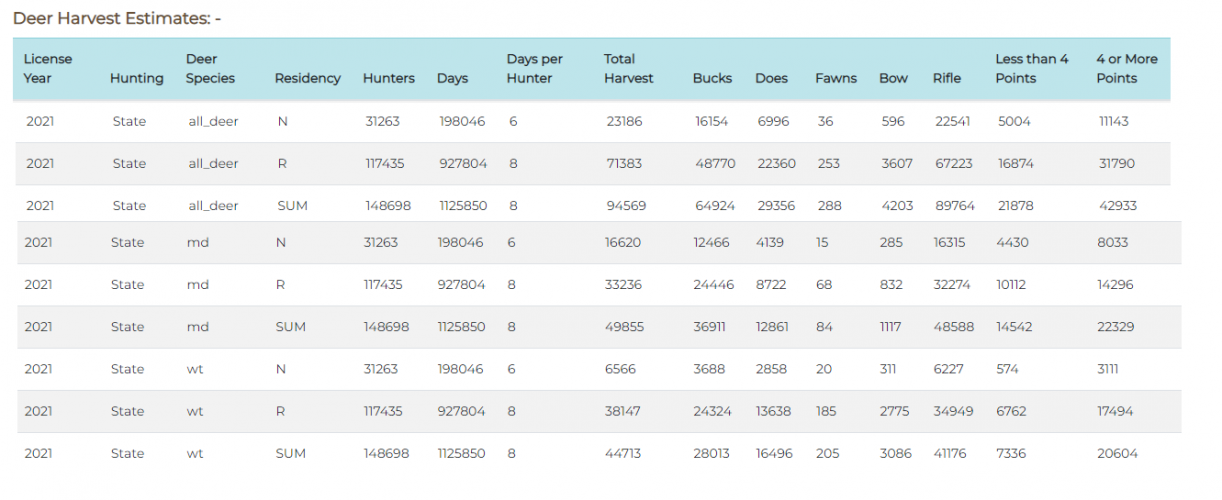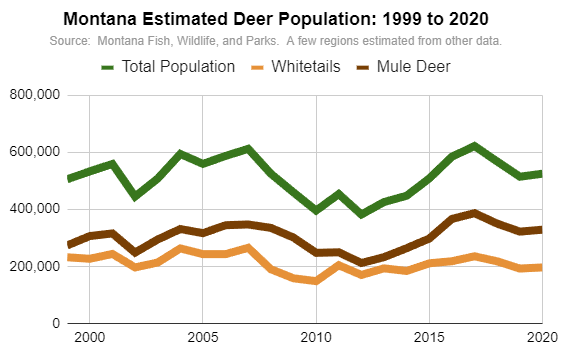Navigation
Install the app
How to install the app on iOS
Follow along with the video below to see how to install our site as a web app on your home screen.
Note: This feature may not be available in some browsers.
More options
You are using an out of date browser. It may not display this or other websites correctly.
You should upgrade or use an alternative browser.
You should upgrade or use an alternative browser.
Montana mule deer rant
- Thread starter brockel
- Start date
No it won't. As long as guys are happy to shoot doe and 2 year old trophy bucks nothing will change. The place is shot out. I am a firm believer that a lot of it is the combination of hunter numbers mixed with the fact 2 big fires removed all the thick cover that deer used to use to be able to hide from the road and UTV hunters. Before the second fire I was still doing ok finding pockets of trees that did not burn and work that cover to find deer. There is very little cover left now and everyone is toting a long range rifle setup it seems so the deer just don't stand a chance. This will be my first year ever that I did not apply for a hunt in MT. The tag price was just not worth it for me and it is a bummer not to see the friends I have made out there but life goes on.There’s a Facebook page called Montanica extreme hunting and fishing. Starting to see posts about the lack of deer numbers. Maybe some eyes will start opening
Bambistew
Well-known member
Maybe Randy can do another how-to video on hunting out there? 
My last time out there was 2012 and I said I'd never go back. We saw more deer in SW MT.
My last time out there was 2012 and I said I'd never go back. We saw more deer in SW MT.
Nameless Range
Well-known member
Maybe Randy can do another how-to video on hunting out there?
My last time out there was 2012 and I said I'd never go back. We saw more deer in SW MT.
I wonder if you would nowadays. There are so many large chunks of SW Montana, beautiful habitat, that are literally void of game
Mtnhunter1
Well-known member
Sad but very true!I wonder if you would nowadays. There are so many large chunks of SW Montana, beautiful habitat, that are literally void of game
Adaptive mule deer management at work behind the scenes in eastern Montana
GLASGOW – Hunters who are used to buying surplus mule deer B licenses right before the general season might have been disappointed this year. However, this reduction in some B licenses in eastern Montana is important to mule deer management.When mule deer numbers are down in large regions of the state, or even in specific hunting districts, Montana Fish, Wildlife & Parks adjusts the number of B licenses in response. The methodology is called adaptive harvest management, and it’s the foundation of mule deer management in Montana.
“When we see localized areas of mule deer numbers trending down, like we are now, we drop the number of licenses we sell,” said Drew Henry, FWP Region 6 supervisor. “That’s what adaptive management is. We monitor numbers closely and have flexibility within the licensing system to respond.”
Although hunters will still see great mule deer opportunities in many parts of eastern Montana, particularly in parts of northeast Montana where mule deer numbers are generally above the long-term average, hunters will see some areas where numbers are lower than in years past. This is largely due to drought, as well as some areas of localized mortality from an epizootic hemorrhagic disease (EHD) outbreak last year. Due to population decreases in hunting districts 620, 630, 670 and 690 compared to the last few years, B-license quotas were reduced prior to the June 1 drawing.
Mule deer counts in southeast Montana, for example, were 36 percent below 2021 numbers and 47 percent below the long-term average. This is the area of the state, including south of Miles City, where habitat was hit hardest by drought and fawn recruitment was low as a result.
In response, FWP issued just 3,000 mule deer B licenses this year for Region 7 as compared to 5,500 tags issued last year and 11,000 in 2020. Historically, these licenses had been selling out by the third week of the season, but this year there were very few left over after the draw, and they were sold out soon after surpluses licenses were offered.
“We know a lot of hunters have been able to pick up a mule deer B license right before the season starts, but that wasn’t the case this year,” said FWP Region 7 supervisor Brad Schmitz. “We knew numbers were trending down and we responded by issuing fewer B licenses. If we get some moisture and a mild winter, we’re confident numbers will bounce right back, like they have in the past.”
This year, hunters may have been confused by the FWP Deer/Elk/Antelope Hunting Regulations Booklet, which routinely display the previous year’s quota. For example, the B license quota for Region 7 in the regulations was 5,500, which was the quota for 2021. This year FWP issued just 3,000. The lag in accurate information is largely due to the early printing of the regulations, which happens before biologists have a chance to fly spring surveys and evaluate the prior year’s harvest information.
FWP has been managing mule deer across the state for decades through Adaptive Harvest Management, which accounts for trends in population size, fawn recruitment, natural mortality of fawns and adults, hunter harvest rates and age structure. FWP biologists monitor these as populations fluctuate over time in response to weather patterns, disease and other stressors. FWP then adjusts hunting regulations for specific areas of the state based on the population data in order to maintain viable populations for current and future hunters and the public to enjoy.
“Mule deer populations in Montana, like other species, are cyclical depending on habitat condition, disease and other factors,” said FWP Region 7 wildlife manager Brett Dorak. “A few years ago, we had some mild winters and wet springs and saw a healthy increase in mule deer numbers. With recent outbreaks of EHD and drought conditions, that changed. We’ve adjusted the B license quotas accordingly, and will look to make more adjustments next year based on our monitoring data.”
Bambistew
Well-known member
That's amazing. Almost 17,000 deer harvested in 2017 from R7. Statewide in CO that year we had about 37,800 deer killed, including whitetails and mule deer.I know, I know... F&G harvest reports are just a wild guess, but here is what is publicly available. This is nuts. I would hate on those NR too if I lived our hunted out that way. That's a big increase in 10 years. About 1/3 of MD buck harvest by NRs comes from unit 700. View attachment 246584
BRI
Well-known member
If there's one thing that's been a constant in most of my 40 years of hunting Montana. Proactive management is not something in the toolbox. It's almost always been reactive and they're generally at the opposite ends of the pendulum.
2021: 9,400 does and fawns harvested in CO vs. 29,600+ in MT. 23% of total deer harvest vs. 31%.
Bambistew
Well-known member
I would be curious to know what the actual harvest is.
The buck to doe ratios are estimated at 39:100 this year in region 7. 2021 pop estimate was ~77,000 deer, That's at most 21k bucks to shoot each year. ~8.6k mule deer bucks were shot last year. Hunters are only shooting 40% of the bucks a year. I have no idea if that's sustainable or not. I suspect that none of the numbers are really accurate. I did read something about the population being down 40% this year compared to long-term average, at least there's that.
@antlerradar you seeing 40 bucks per 100 does? I'm guessing they're counting buck fawns?
It's just thumb suck all the way around. The numbers based on a little info here (call 5000 hunters and ask if they shot an elk or saw a wolf), a little info there (compare check station success rates which are open 2 days a week 10am - 3pm). Then take it all and line it up with some population model (estimate based on driving down the highway) and call it good.
The buck to doe ratios are estimated at 39:100 this year in region 7. 2021 pop estimate was ~77,000 deer, That's at most 21k bucks to shoot each year. ~8.6k mule deer bucks were shot last year. Hunters are only shooting 40% of the bucks a year. I have no idea if that's sustainable or not. I suspect that none of the numbers are really accurate. I did read something about the population being down 40% this year compared to long-term average, at least there's that.
@antlerradar you seeing 40 bucks per 100 does? I'm guessing they're counting buck fawns?
It's just thumb suck all the way around. The numbers based on a little info here (call 5000 hunters and ask if they shot an elk or saw a wolf), a little info there (compare check station success rates which are open 2 days a week 10am - 3pm). Then take it all and line it up with some population model (estimate based on driving down the highway) and call it good.
D
Deleted member 28227
Guest
Add in predators, winter kill, cars, whatever you could be looking at the majority of all bucks being killed every year.I would be curious to know what the actual harvest is.
The buck to doe ratios are estimated at 39:100 this year in region 7. 2021 pop estimate was ~77,000 deer, That's at most 21k bucks to shoot each year. ~8.6k mule deer bucks were shot last year. Hunters are only shooting 40% of the bucks a year. I have no idea if that's sustainable or not. I suspect that none of the numbers are really accurate. I did read something about the population being down 40% this year compared to long-term average, at least there's that.
@antlerradar you seeing 40 bucks per 100 does? I'm guessing they're counting buck fawns?
It's just thumb suck all the way around. The numbers based on a little info here (call 5000 hunters and ask if they shot an elk or saw a wolf), a little info there (compare check station success rates which are open 2 days a week and close before most people go past). Then take it all and line it up with some population model (estimate based on driving down the highway) and call it good.
rogerthat
Well-known member
- Joined
- Aug 29, 2015
- Messages
- 3,132
Now if only that graph were accurate…but it’s not.
rogerthat
Well-known member
- Joined
- Aug 29, 2015
- Messages
- 3,132
Knocking it out of the park…better than any limited entry unit in the west…even better than the Henry mountains…can’t make this stuff up
Fairly certain you would have a hard time finding many hunters in any unit private or public land anywhere in Montana that would say we have just as many mule deer now as we did early 2000’s. It’s not even close.
There's a lot of amusing statements in this garbage.Adaptive mule deer management at work behind the scenes in eastern Montana
GLASGOW – Hunters who are used to buying surplus mule deer B licenses right before the general season might have been disappointed this year. However, this reduction in some B licenses in eastern Montana is important to mule deer management.
When mule deer numbers are down in large regions of the state, or even in specific hunting districts, Montana Fish, Wildlife & Parks adjusts the number of B licenses in response. The methodology is called adaptive harvest management, and it’s the foundation of mule deer management in Montana.
“When we see localized areas of mule deer numbers trending down, like we are now, we drop the number of licenses we sell,” said Drew Henry, FWP Region 6 supervisor. “That’s what adaptive management is. We monitor numbers closely and have flexibility within the licensing system to respond.”
Although hunters will still see great mule deer opportunities in many parts of eastern Montana, particularly in parts of northeast Montana where mule deer numbers are generally above the long-term average, hunters will see some areas where numbers are lower than in years past. This is largely due to drought, as well as some areas of localized mortality from an epizootic hemorrhagic disease (EHD) outbreak last year. Due to population decreases in hunting districts 620, 630, 670 and 690 compared to the last few years, B-license quotas were reduced prior to the June 1 drawing.
Mule deer counts in southeast Montana, for example, were 36 percent below 2021 numbers and 47 percent below the long-term average. This is the area of the state, including south of Miles City, where habitat was hit hardest by drought and fawn recruitment was low as a result.
In response, FWP issued just 3,000 mule deer B licenses this year for Region 7 as compared to 5,500 tags issued last year and 11,000 in 2020. Historically, these licenses had been selling out by the third week of the season, but this year there were very few left over after the draw, and they were sold out soon after surpluses licenses were offered.
“We know a lot of hunters have been able to pick up a mule deer B license right before the season starts, but that wasn’t the case this year,” said FWP Region 7 supervisor Brad Schmitz. “We knew numbers were trending down and we responded by issuing fewer B licenses. If we get some moisture and a mild winter, we’re confident numbers will bounce right back, like they have in the past.”
This year, hunters may have been confused by the FWP Deer/Elk/Antelope Hunting Regulations Booklet, which routinely display the previous year’s quota. For example, the B license quota for Region 7 in the regulations was 5,500, which was the quota for 2021. This year FWP issued just 3,000. The lag in accurate information is largely due to the early printing of the regulations, which happens before biologists have a chance to fly spring surveys and evaluate the prior year’s harvest information.
FWP has been managing mule deer across the state for decades through Adaptive Harvest Management, which accounts for trends in population size, fawn recruitment, natural mortality of fawns and adults, hunter harvest rates and age structure. FWP biologists monitor these as populations fluctuate over time in response to weather patterns, disease and other stressors. FWP then adjusts hunting regulations for specific areas of the state based on the population data in order to maintain viable populations for current and future hunters and the public to enjoy.
“Mule deer populations in Montana, like other species, are cyclical depending on habitat condition, disease and other factors,” said FWP Region 7 wildlife manager Brett Dorak. “A few years ago, we had some mild winters and wet springs and saw a healthy increase in mule deer numbers. With recent outbreaks of EHD and drought conditions, that changed. We’ve adjusted the B license quotas accordingly, and will look to make more adjustments next year based on our monitoring data.”
It would be interesting to know who in FWP actually writes this crap, like seriously who put the pen to the paper and wrote this? I know there's some facts provide, but some of the other statements are hilarious.
"hunters may have been confused by the FWP Deer/Elk/Antelope Hunting Regulations"
"FWP has been managing mule deer across the state for decades through Adaptive Harvest Management"
D
Deleted member 28227
Guest
Muley's alone... I'm assuming CO has like 8000 or something total so their numbers aren't significant.2021: 9,400 does and fawns harvested in CO vs. 29,600+ in MT. 23% of total deer harvest vs. 31%.
MT 328,000 Does 12861, 4 does killed per 100 deer
CO 427,000 Does 8770, 2 does killed per 100 deer
So MT is killing 2x as many does as CO on a relative basis.
antlerradar
Well-known member
For the most part when I go scouting, I don't go where there are not many does, so on scouting trips I see a much higher percentage of bucks, on the other had if I were to look in the irrigated hay fields the percentage of bucks is much lower.I would be curious to know what the actual harvest is.
The buck to doe ratios are estimated at 39:100 this year in region 7. 2021 pop estimate was ~77,000 deer, That's at most 21k bucks to shoot each year. ~8.6k mule deer bucks were shot last year. Hunters are only shooting 40% of the bucks a year. I have no idea if that's sustainable or not. I suspect that none of the numbers are really accurate. I did read something about the population being down 40% this year compared to long-term average, at least there's that.
@antlerradar you seeing 40 bucks per 100 does? I'm guessing they're counting buck fawns?
It's just thumb suck all the way around. The numbers based on a little info here (call 5000 hunters and ask if they shot an elk or saw a wolf), a little info there (compare check station success rates which are open 2 days a week 10am - 3pm). Then take it all and line it up with some population model (estimate based on driving down the highway) and call it good.
My early morning drive was likely a much better cross section of region 7. Four of the 21 deer were bucks, so about half of what FWP is claiming.
Similar threads
Latest posts
-
-
-
Help Me Legalize Semiauto Rifle Big Game Hunting In Pennsylvania
- Latest: Rack Daniels
-
Turkey DNA initiative started, requesting hunter harvested samples
- Latest: Rack Daniels










